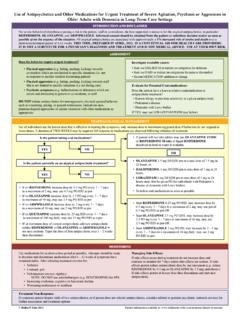Transcription of Accommodating and Managing Behavioural and ... - …
1 Part 1: Interdisciplinary Decisional and Practice Support for BPSDA ccommodating and Managing Behavioural and Psychological Symptoms of dementia (BPSD) in Residential Care Nov8, 2013(V16)Care Planning/EvaluationAssessmentProblem SolvingEMOTIONAL Common Emotional changes in dementia New and/or past history of mental illness ENVIRONMENTC onsider proper: Signage Lighting Colour scheme Over and under stimulation Change in routine Relocation OtherINTELLECTUAL Common Intellectual Changes in dementia CommunicationSOCIAL Isolation Loneliness Boredom Task focused non-supportive care approach Multiple losses Life Story Social Network Cultural heritagePHYSICAL Common physical changes in dementia Unmet Needs Medical co-morbidity/change in medical condition Medication/side effects/ Polypharmacy Pain FallsAnalyze data from Behaviour Assessment to determine possible cause(s) and triggers (Engage Resident/Family/Substitute Decision Maker)PIECES1 ( )
2 CAPABLITIES Residual strengths and abilities Progressively lowered stress threshold CommunicationCreate an individualized care plan of specific non-pharmacological interventionsthat addresses modifiable causes of behaviour (Engage Resident/Family/ Substitute Decision Maker)Mitigate consequencesEducate staff and familyMonitor Behavioural response to planned strategiesConsider how RAI CAPs triggered and outcome scales have changedInterdisciplinary consultation with relevant teams as neededPART IIImprovement Continue to monitor for any changes Decreased intensity, frequency, duration Document improvement and adjust plan of care as required Monitor and evaluateNo Improvement Review plan Adjust strategies Implement revised plan; monitor and evaluateYesAssess Behaviour using appropriate assessment tool Evaluate the Consequences of the behaviour (resident and others) and Physician Medications for emergencies SBAR for BPSD Refer to Part IIEvaluate for possible Antecedents (triggers) Person with dementia has Behavioural & Psychological Symptoms of dementia (BPSD)(Identify and document baseline behaviour in neutral terms with collateral input)Emergency Consider delirium or exacerbation due to ongoing, active medical problem(s) Least restraintCohen Mansfield Agitation Inventory (CMAI) dementia Observation Scale (DOS)Resident Assessment Instrument (RAI) Changed Outcome Scales?
3 (eg. Pain, CPS, DRS, ABS, ADL etc). New CAPS/RAPSE valuate Progress Notes for Behavioural events1 Consult Group (2008). Putting the Together: A Model for Collaborative Care and Changing Practice 6th Edition(R). Canada. with acknowledgement of the antecedentsBest Practice Tips: Encourage involvement and education of family/caregiver/substitute decision maker in the life of the older person with dementia , including decision-making process Involve all members of the resident s care team throughout the decision-making processFor further information refer to:BC Best Practice Guideline for Accommodating and Managing Behavioural and Psychological Symptoms of dementia in Residential Care Canadian Coalition for Seniors Mental Health (CCSMH). National Guidelines for Senior s Mental Health: the assessment and treatment of mental health issues in long-term care homes.
4 There severe urgent risk for safety of resident, care staff or others? Or is this an acute change?Depression Screening ToolsPart II Reassessment with Family Physician or Nurse Practitioner for BPSDA ccommodating and Managing BPSD in Residential CareCare Planning/EvaluationMedication OptionsAssessmentClinical Assessment - untreated medical conditions - review current medications / side effects Consider pharmacologic treatment for BPSD - behaviour is dangerous, distressing, disturbing, damaging to social relationships and persistent AND - has not responded to comprehensive non-pharmacologic treatment plan, including removal of offending drugsIs behaviour likely to respond to medication?No: these behaviours are not likely to respond to medicationReturn to Part IYes: These behaviours may respond to medication and benefits outweigh the risksSLEEP DISTURBANCES edativesPSYCHOSIS: Atypical Antipsychotics Typical AntipsychoticsChEI (First line intervention for Lewy Body, Parkinson) AGGRESSION: (Physical/Verbal) Atypical Antipsychotics Typical AntipsychoticsOther DEPRESSION: SSRI SNRI NaSSAANXIETY.
5 SSRI Trazodone Benzodiazepine Regularly monitor effectiveness of treatment, side effects, titrate dose (review with residential care team and family)In consultation with resident/family/SDM decide if therapeutic goals are met Do not stop psychotropic medication when prescribed for another indication besides behaviour Schizophrenia, Bipolar, Major Depression Reassess the need for continued therapyDiscontinue medication if possible Monitor for recurrence / emergence of BPSD Contact resident/family/substitute decision maker and obtain informed consent prior to initiation of pharmacological treatment (document and provide family/SDM with information)Continue to follow individualized care plan for BPSDC ontinue to provide individualized care plan for BPSDE ducate staff and familyInterdisciplinary consultation with relevant specialist teams( Geriatric Psychiatry, Pain Specialist, etc.)
6 Consider initiating or continuing current ChEI /Memantine treatment for Alzheimer s Disease.




